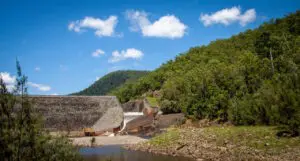Electricity generated from gas-fired power stations fell dramatically in 2020, according to a new analysis from the Climate Council, despite the Morrison government embracing the fossil fuel as part of its Covid-19 economic response.
Gas-fired generation fell by 19 per cent in 2020, while output from wind and solar projects continued to surge, as the Covid-19 pandemic led to subdued demand for electricity seeing higher-cost gas squeezed out of the market.
According to the new analysis published by the Climate Council on Tuesday, the market share of renewable energy grew to 26 per cent in 2020 in the National Electricity Market, while gas fell to just 8 per cent of the electricity supply.
“This latest data clearly shows that gas is on the way out and has no role to play in our economic recovery. It is foolish to waste taxpayers’ money building new gas power stations. It is completely unnecessary,” Climate Council researcher Tim Baxter said.
“The Federal Government needs to abandon the folly of new gas in the electricity sector and let the states and territories get on with the energy transition and economic recovery.”
According to electricity data platform OpenNEM, in 2020 gas generators produced 15,143GWh of electricity in Australia’s main grid, the lowest total since 2006.
Gas generators played their biggest roll in supplying power in Western Australia and South Australia, where they provided around 40 per cent of electricity generation.
However, 2020 saw demand for gas generation collapse in larger states, particularly New South Wales and Victoria, where gas generator market share slumped to just 1.6 and 3.1 per cent, respectively – significantly below the total market share of renewable energy sources.
Last year, renewables supplied 99 per cent of electricity generated in Tasmania, 58.5 per of power in South Australia an more than a quarter of electricity produced in Western Australia and Victoria.
Due to the growing supply of low-cost power from wind and solar projects, the role of higher cost gas power in the market is becoming increasingly squeezed and is largely being limited to peak demand periods.
The Climate Council pointed to the Integrated System Plan, prepared by the Australian Energy Market Operator, which outlined expectations at gas generators would continue to play a diminishing role in the electricity market, ranking as one of the higher cost energy sources.
The ISP found that while a future energy system may continue to draw upon gas generation for important peak supply and system stability services, it is likely that there will be an overall decline in gas use for electricity generation into the future.
Baxter says that this result was ultimately a positive one for the environment, as it would help reduce emissions from the use of fossil fuels.
“Gas is a fossil fuel driving climate change and Australians are being hit hard with catastrophic bushfires and the third mass bleaching of the Great Barrier Reef in five years. The good news is we do not need any new gas infrastructure,” Baxter said.
“Renewables and storage are affordable, reliable and clean. They create jobs, attract investment across regional Australia and drive down power bills.”
The decline of gas in the electricity sector comes as the Morrison government has directed public funding into the gas sector to support the development of up to five gas basins, as part of a ‘gas-led economic recovery’ touted by the government as a response to the economic impact of Covid-19.
A total of $52.9 million in funding was allocated to gas projects in last year’s federal budget, with a further $173 million allocated to the Beetaloo gas project in the Northern Territory to help cover the cost of building roads for the project.
Federal energy and emissions reduction minister, Angus Taylor, acknowledged the strong growth of renewables in 2020, citing Clean Energy Regulator estimates that more than 7GW of new renewable capacity was added to the grid last year. This growth was underpinned by record uptake of rooftop solar systems.
An estimated one-in-four Australian households now have rooftop solar installed, with total installed capacity surpassing 13GW last year.
“This is helping to reduce household energy bills and reduce emissions,” Taylor said.









